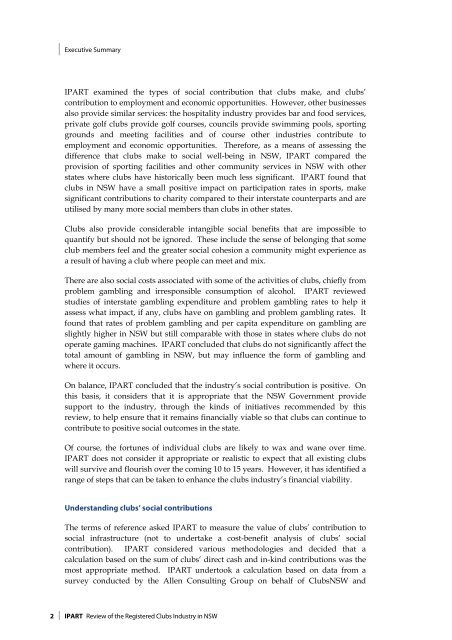Review of the Registered Clubs Industry in NSW - Clubs NSW
Review of the Registered Clubs Industry in NSW - Clubs NSW
Review of the Registered Clubs Industry in NSW - Clubs NSW
You also want an ePaper? Increase the reach of your titles
YUMPU automatically turns print PDFs into web optimized ePapers that Google loves.
Executive Summary<br />
IPART exam<strong>in</strong>ed <strong>the</strong> types <strong>of</strong> social contribution that clubs make, and clubs’<br />
contribution to employment and economic opportunities. However, o<strong>the</strong>r bus<strong>in</strong>esses<br />
also provide similar services: <strong>the</strong> hospitality <strong>in</strong>dustry provides bar and food services,<br />
private golf clubs provide golf courses, councils provide swimm<strong>in</strong>g pools, sport<strong>in</strong>g<br />
grounds and meet<strong>in</strong>g facilities and <strong>of</strong> course o<strong>the</strong>r <strong>in</strong>dustries contribute to<br />
employment and economic opportunities. Therefore, as a means <strong>of</strong> assess<strong>in</strong>g <strong>the</strong><br />
difference that clubs make to social well-be<strong>in</strong>g <strong>in</strong> <strong>NSW</strong>, IPART compared <strong>the</strong><br />
provision <strong>of</strong> sport<strong>in</strong>g facilities and o<strong>the</strong>r community services <strong>in</strong> <strong>NSW</strong> with o<strong>the</strong>r<br />
states where clubs have historically been much less significant. IPART found that<br />
clubs <strong>in</strong> <strong>NSW</strong> have a small positive impact on participation rates <strong>in</strong> sports, make<br />
significant contributions to charity compared to <strong>the</strong>ir <strong>in</strong>terstate counterparts and are<br />
utilised by many more social members than clubs <strong>in</strong> o<strong>the</strong>r states.<br />
<strong>Clubs</strong> also provide considerable <strong>in</strong>tangible social benefits that are impossible to<br />
quantify but should not be ignored. These <strong>in</strong>clude <strong>the</strong> sense <strong>of</strong> belong<strong>in</strong>g that some<br />
club members feel and <strong>the</strong> greater social cohesion a community might experience as<br />
a result <strong>of</strong> hav<strong>in</strong>g a club where people can meet and mix.<br />
There are also social costs associated with some <strong>of</strong> <strong>the</strong> activities <strong>of</strong> clubs, chiefly from<br />
problem gambl<strong>in</strong>g and irresponsible consumption <strong>of</strong> alcohol. IPART reviewed<br />
studies <strong>of</strong> <strong>in</strong>terstate gambl<strong>in</strong>g expenditure and problem gambl<strong>in</strong>g rates to help it<br />
assess what impact, if any, clubs have on gambl<strong>in</strong>g and problem gambl<strong>in</strong>g rates. It<br />
found that rates <strong>of</strong> problem gambl<strong>in</strong>g and per capita expenditure on gambl<strong>in</strong>g are<br />
slightly higher <strong>in</strong> <strong>NSW</strong> but still comparable with those <strong>in</strong> states where clubs do not<br />
operate gam<strong>in</strong>g mach<strong>in</strong>es. IPART concluded that clubs do not significantly affect <strong>the</strong><br />
total amount <strong>of</strong> gambl<strong>in</strong>g <strong>in</strong> <strong>NSW</strong>, but may <strong>in</strong>fluence <strong>the</strong> form <strong>of</strong> gambl<strong>in</strong>g and<br />
where it occurs.<br />
On balance, IPART concluded that <strong>the</strong> <strong>in</strong>dustry’s social contribution is positive. On<br />
this basis, it considers that it is appropriate that <strong>the</strong> <strong>NSW</strong> Government provide<br />
support to <strong>the</strong> <strong>in</strong>dustry, through <strong>the</strong> k<strong>in</strong>ds <strong>of</strong> <strong>in</strong>itiatives recommended by this<br />
review, to help ensure that it rema<strong>in</strong>s f<strong>in</strong>ancially viable so that clubs can cont<strong>in</strong>ue to<br />
contribute to positive social outcomes <strong>in</strong> <strong>the</strong> state.<br />
Of course, <strong>the</strong> fortunes <strong>of</strong> <strong>in</strong>dividual clubs are likely to wax and wane over time.<br />
IPART does not consider it appropriate or realistic to expect that all exist<strong>in</strong>g clubs<br />
will survive and flourish over <strong>the</strong> com<strong>in</strong>g 10 to 15 years. However, it has identified a<br />
range <strong>of</strong> steps that can be taken to enhance <strong>the</strong> clubs <strong>in</strong>dustry’s f<strong>in</strong>ancial viability.<br />
Understand<strong>in</strong>g clubs’ social contributions<br />
The terms <strong>of</strong> reference asked IPART to measure <strong>the</strong> value <strong>of</strong> clubs’ contribution to<br />
social <strong>in</strong>frastructure (not to undertake a cost-benefit analysis <strong>of</strong> clubs’ social<br />
contribution). IPART considered various methodologies and decided that a<br />
calculation based on <strong>the</strong> sum <strong>of</strong> clubs’ direct cash and <strong>in</strong>-k<strong>in</strong>d contributions was <strong>the</strong><br />
most appropriate method. IPART undertook a calculation based on data from a<br />
survey conducted by <strong>the</strong> Allen Consult<strong>in</strong>g Group on behalf <strong>of</strong> <strong>Clubs</strong><strong>NSW</strong> and<br />
2 IPART <strong>Review</strong> <strong>of</strong> <strong>the</strong> <strong>Registered</strong> <strong>Clubs</strong> <strong>Industry</strong> <strong>in</strong> <strong>NSW</strong>
















